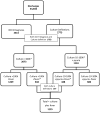A comparison of methods to detect urinary tract infections using electronic data
- PMID: 20873674
- PMCID: PMC2948408
- DOI: 10.1016/s1553-7250(10)36060-0
A comparison of methods to detect urinary tract infections using electronic data
Abstract
Background: The use of electronic medical records to identify common health care-associated infections (HAIs), including pneumonia, surgical site infections, bloodstream infections, and urinary tract infections (UTIs), has been proposed to help perform HAI surveillance and guide infection prevention efforts. Increased attention on HAIs has led to public health reporting requirements and a focus on quality improvement activities around HAIs. Traditional surveillance to detect HAIs and focus prevention efforts is labor intensive, and computer algorithms could be useful to screen electronic data and provide actionable information.
Methods: Seven computer-based decision rules to identify UTIs were compared in a sample of 33,834 admissions to an urban academic health center. These decision rules included combinations of laboratory data, patient clinical data, and administrative data (for example, International Statistical Classification of Diseases and Related Health Problems, Ninth Revision [ICD-9] codes).
Results: Of 33,834 hospital admissions, 3,870 UTIs were identified by at least one of the decision rules. The use of ICD-9 codes alone identified 2,614 UTIs. Laboratory-based definitions identified 2,773 infections, but when the presence of fever was included, only 1,125 UTIs were identified. The estimated sensitivity of ICD-9 codes was 55.6% (95% confidence interval [CI], 52.5%-58.5%) when compared with a culture- and symptom-based definition. Of the UTIs identified by ICD-9 codes, 167/1,125 (14.8%) also met two urine-culture decision rules.
Discussion: Use of the example of UTI identification shows how different algorithms may be appropriate, depending on the goal of case identification. Electronic surveillance methods may be beneficial for mandatory reporting, process improvement, and economic analysis.
Conflict of interest statement
The authors have no conflict of interests to declare.
Figures

Similar articles
-
The accuracy of fully automated algorithms for surveillance of healthcare-associated urinary tract infections in hospitalized patients.J Hosp Infect. 2021 Apr;110:139-147. doi: 10.1016/j.jhin.2021.01.023. Epub 2021 Feb 3. J Hosp Infect. 2021. PMID: 33548370
-
First year of mandatory reporting of healthcare-associated infections, Pennsylvania: an infection control-chart abstractor collaboration.Infect Control Hosp Epidemiol. 2006 Sep;27(9):926-30. doi: 10.1086/507281. Epub 2006 Aug 14. Infect Control Hosp Epidemiol. 2006. PMID: 16941317
-
Administrative coding data and health care-associated infections.Clin Infect Dis. 2009 Sep 15;49(6):949-55. doi: 10.1086/605086. Clin Infect Dis. 2009. PMID: 19663692 Review.
-
Comparison of two computer algorithms to identify surgical site infections.Surg Infect (Larchmt). 2011 Dec;12(6):459-64. doi: 10.1089/sur.2010.109. Epub 2011 Dec 2. Surg Infect (Larchmt). 2011. PMID: 22136489 Free PMC article.
-
Folic acid supplementation and malaria susceptibility and severity among people taking antifolate antimalarial drugs in endemic areas.Cochrane Database Syst Rev. 2022 Feb 1;2(2022):CD014217. doi: 10.1002/14651858.CD014217. Cochrane Database Syst Rev. 2022. PMID: 36321557 Free PMC article.
Cited by
-
Changes in the incidence and antimicrobial susceptibility of healthcare-associated infections in a New York hospital system, 2006-2012.J Prev Med Hyg. 2017 Dec 30;58(4):E294-E301. doi: 10.15167/2421-4248/jpmh2017.58.4.774. eCollection 2017 Dec. J Prev Med Hyg. 2017. PMID: 29707660 Free PMC article.
-
Quantifying guideline-discordant intermittent catheterization in adults hospitalized with spinal cord injury: a retrospective cohort study.Spinal Cord. 2025 May;63(5):270-276. doi: 10.1038/s41393-025-01078-w. Epub 2025 Apr 29. Spinal Cord. 2025. PMID: 40301533 Free PMC article.
-
Temporal trends and risk factors for extended-spectrum beta-lactamase-producing Escherichia coli in adults with catheter-associated urinary tract infections.Antimicrob Resist Infect Control. 2014 Dec 27;3(1):39. doi: 10.1186/s13756-014-0039-y. eCollection 2014. Antimicrob Resist Infect Control. 2014. PMID: 25625011 Free PMC article.
-
Overdiagnosis of urinary tract infection linked to overdiagnosis of pneumonia: a multihospital cohort study.BMJ Qual Saf. 2022 May;31(5):383-386. doi: 10.1136/bmjqs-2021-013565. Epub 2022 Jan 5. BMJ Qual Saf. 2022. PMID: 34987084 Free PMC article.
-
Nurse Staffing and Healthcare-Associated Infection, Unit-Level Analysis.J Nurs Adm. 2019 May;49(5):260-265. doi: 10.1097/NNA.0000000000000748. J Nurs Adm. 2019. PMID: 31008835 Free PMC article.
References
-
- Stone PW, Braccia D, Larson E. Systematic review of economic analyses of health care-associated infections. Am J Infect Control. 2005 Nov;33:501–9. - PubMed
-
- Scott RD. The direct medical costs of healthcare-associated infections in U.S. hospitals and the benefits of prevention. [(last accessed April 8, 2010)]. http://www.cdc.gov/ncidod/dhqp/pdf/Scott_CostPaper.pdf.
-
- Arias KA. Surveillance. In: Carrico Ruth., editor. APIC text of infection control and epidemiology. 3. Washington, DC: APIC; 2009.
Publication types
MeSH terms
Grants and funding
LinkOut - more resources
Full Text Sources
Medical
Miscellaneous

